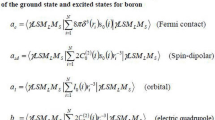Abstract
An ab initio approach based on effective core potentials (ECPs), core polarization potentials (CPPs) with three valence electrons and multireference configuration interaction (MRCI) level of calculation is used to determine the adiabatic potential energy curves, the spectroscopic constants and the permanent and transition electric dipole moments of the lowest doublet and quartet electronic states of BaCs. These sates are dissociating into the first six asymptotic limits of the alkali–alkaline earth molecule, BaCs. Only the ground state has been studied in the literature, and the comparison with the available results has shown a very good agreement. The spin–orbit interaction has been included in the next step of our calculation, and its effect on the potential energy curves and spectroscopic parameters on the Ω representation states has been thoroughly studied. Both relativistic and nonrelativistic calculations of permanent and transition dipole moments are also presented, which allows us to determine the influence of relativistic effects on the dipole moment.











Similar content being viewed by others
References
Micheli A, Brennen GK, Zoller PA (2006) Toolbox for lattice-spin models with polar molecules. Nat Phys 2:341–347
Idziaszek Z, Calarco T, Zoller P (2007) Controlled collisions of a single atom and an ion guided by movable trapping potentials. Phys Rev A 76:033409
Doerk H, Idziaszek Z, Calarco T (2010) Atom-ion quantum gate. Phys Rev A 81:012708
DeMille D (2002) Quantum computation with trapped polar molecules. Phys Rev Lett 88:067901
Menotti C, Lewenstein M, Lahaye T, Pfau T (2008) Dipolar interaction in ultra-cold atomic gases. AIP Conf Proc 970:332
Stuhler J, Griesmaier A, Koch T, Fattori M, Pfau T, Giovanazzi S, Pedri P, Santos L (2005) Magnetostriction in a degenerate dipolar quantum gas. Phys Rev Lett 95:150406
Martinez de Escobar YN, Mickelson PG, Yan M, DeSalvo BJ, Nagel SB, Killian TC (2009) Bose–Einstein condensation of 84Sr. Phys Rev Lett 103:200402
Lercher AD, Takekoshi T, Debatin M, Schuster B, Rameshan R, Ferlaino F, Grimm R, Nägerl H-C (2011) Production of a dual-species Bose–Einstein condensate of Rb and Cs atoms. Eur Phys J D 65:3–9
Kraft S, Vogt F, Appel O, Riehle F, Sterr U (2009) Bose–Einstein condensation of alkaline earth atoms: 40Ca. Phys Rev Lett 103:130401
You Y, Yang CL, Wang MS, Ma XG, Liu WW (2015) An ab initio study of the ground and low-lying excited states of LiBe+. J At Mol Sci 6:63–71
You Y, Yang CL, Wang MS, Ma XG, Liu WW, Wang LZ (2015) Construction of analytic functions for the potential energy curves, dipole moments, and transition dipole moments of RbBe and CsBe molecules. J Quantum Spectrosc Radiat Transf 165:56–67
Xiao KL, Yang CL, Wang MS, Ma XG, Liu WW (2013) An ab initio study of the ground and low-lying excited states of KBe with the effect of inner-shell electrons. J Chem Phys 139:074305
Augustovicova L, Soldan P (2012) Ab initio properties of MgAlk (Alk = Li, Na, K, Rb, Cs). J Chem Phys 136:084311
Kotochigova S, Petrov A, Linnik M, Kłos J, Julienne PS (2011) Ab initio properties of Li-group-II molecules for ultracold matter studies. J Chem Phys 135:164108
Gopakumar G, Abe M, Hada M, Kajita M (2014) Dipole polarizability of alkali-metal (Na, K, Rb)–alkaline earth-metal (Ca, Sr) polar molecules: prospects for alignment. J Chem Phys 140:224303
Zuchowski PS, Guerout R, Dulieu O (2014) Ground- and excited-state properties of the polar and paramagnetic RbSr molecule: a comparative study. Phys Rev A 90:012507
Guerout R, Aymar M, Dulieu O (2010) Ground state of the polar alkali-metal-atom–strontium molecules: potential energy curve and permanent dipole moment. Phys Rev A 82:042508
Allouche AR, Aubert-Frécon M (1994) Electronic structure of BaLi. I. Theoretical study. J Chem Phys 100:938
Boutassetta N, Allouche AR, Aubert-Frécon M (1994) Theoretical study of the low-lying electronic states of the BaNa molecule. J Chem Phys 33:189
Boutassetta N, Allouche AR, Aubert-Frécon M (1995) Theoretical study of the low-lying electronic states of the BaK molecule. J Chem Phys 393:201
Gao Y, Gao T (2014) Laser cooling of the alkaline-earth-metal monohydrides: insights from an ab initio theory study. Phys Rev A 90:052506
Di Rosa MD (2004) Laser-cooling molecules. Eur Phys J D 31:395
Yadin B, Veness T, Conti P, Hill C, Yurchenko SN, Tennyson J (2012) The rovibrational spectrum of BeH, MgH and CaH at high temperatures in the X2Σ+ state: a theoretical study. Mon Not R Astron Soc 425:34
Mostafanejad M, Shayesteh A (2012) Ab initio potential energy curves and transition dipole moments for the X2Σ+, A2Π and B′2Σ+ states of MgH. Chem Phys Lett 551:13
Allouche AR, Nicolas G, Barthelat JC, Spiegelmann F (1992) Theoretical study of the electronic structure of the BaH molecule. J Chem Phys 96:7646
Gou D, Kuang X, Gao Y, Huo D (2015) Theoretical study on the ground state of the polar alkali metal-barium molecules: potential energy curve and permanent dipole moment. J Chem Phys 142:034308
Krois G, Pototschnig JV, Lackner F, Ernst WE (2013) Spectroscopy of cold LiCa molecules formed on helium nanodroplets. J Phys Chem A 117:13719–13731
Stringat R, Fabre G, Boulezhar A, Dincan J, Effantin C, Vérges J, Bernard A (1994) The X2Σ+, (2)2Σ+, and (2)2Π States of BaLi. J Mol Spectrosc 168:514–521
D’Incan J, Effantin C, Bernard A, Fabre G, Stringat R, Boulezhar A, Vérges J (1994) Electronic structure of BaLi. II. First observation of the Ba6,7Li spectrum: analysis of the (2)2Π → X 2Σ+ system. J Chem Phys 100:945
Vérges J, D’Incan J, Effantin C, Bernard A, Fabre G, Stringat R, Boulzhar A (1994) Electronic structure of BaLi: the (2)2Sigma+ state. J Phys B 153:27
Berry KR, Duncan MA (1997) Photoionization spectroscopy of LiMg. Chem Phys Lett 279:44–49
Pototschnig JV, Krois G, Lackner F, Ernst WE (2015) Investigation of the RbCa molecule: experiment and theory. J Mol Spec 310:126–134
Szczepkowski J, Grochola A, Kowalczyk P, Dulieu O, Guérout R, Żuchowski PS, Jastrzebski W (2018) Experimental and theoretical study of the B(2)2Σ+→ X(1)2Σ+ system in the KSr molecule. J Quantum Spectrosc Radiat Transf 210:217–244
Werner HJ, Knowles PJ (1985) A second order multiconfiguration SCF procedure with optimum convergence. J Chem Phys 82:5053
Knowles PJ, Werner HJ (1985) An efficient second-order MC SCF method for long configuration expansions. Chem Phys Lett 115:259–276
Werner HJ, Knowles PJ, Knizia G, Manby FR, Schütz M et al. (2010) MOLPRO version 2010.1, a package of ab initio programs. http://www.molpro.net. Accessed 9 Apr 2019
Muller W, Flesch J, Meyer W (1984) Treatment of intershell correlation effects in ab initio calculations by use of core polarization potentials. Method and application to alkali and alkaline earth atoms. J Chem Phys 80:3297
Pototschnig JV, Meyer R, Hauser AW, Ernst WE (2017) Vibronic transitions in the alkali-metal (Li, Na, K, Rb)–alkaline-earth-metal (Ca, Sr) series: a systematic analysis of de-excitation mechanisms based on the graphical mapping of Frank–Condon integrals. Phys Rev A 95:022501
Pototschnig JV, Krois G, Lackner F, Ernst WE (2014) Ab initio study of the RbSr electronic structure: potential energy curves, transition dipole moments, and permanent electric dipole moments. J Chem Phys 141:234309
Stevens WJ, Krauss H, Basch H, Jasien PG (1992) Relativistic compact effective potentials and efficient, shared-exponent basis sets for the third-, fourth-, and fifth-row atoms Can. J Chem 70:612–630
Jones RR, Gallagher TF (1989) Observation of Ba+np1/2 and ngj Rydberg series. J Opt Sot Am B 6:1467–1472
Kramida AE, Ralchenko Y, Reader J, NIST ASD Team (2018) NIST atomic spectra database (ver. 5.5.6). National Institute of Standards and Technology, Gaithersburg
Raghavachari K, Trucks GW, Pople JA, Head-Gordon M (1989) A fifth-order perturbation comparison of electron correlation theories. Chem Phys Lett 157:479–483
Boys SF, Bernardi F (1970) The calculation of small molecular interactions by the differences of separate total energies. Some procedures with reduced errors. Mol Phys 19:553–566
Schchardt KL, Didier BT, Elsethagen T, Sun L, Gurumoorthi V, Chase J, Li J, Windus TL (2007) Basis set exchange: a community database for computational sciences. J Chem Inf Model 47:1045–1052
Bauschlicher CW, Jaffe RL, Langhoff SR, Mascarello FG, Partridge H (1985) Oscillator strengths of some Ba lines; a treatment including core–valence correlation and relativistic effects. J Phys B 18:2147
Pavolini D, Gustavsson T, Spiegelmann F, Daudey JP (1989) Theoretical study of the excited states of the heavier alkali dimers. I. The RbCs molecule. J Phys B At Mol Opt Phys 22:1721
Shaik S, Ioffe A, Reddy AC, Pross A (1994) Is the avoided crossing state a good approximation for the transition state of a chemical reaction? An analysis of Menschutkin and ionic Sn2 reactions. J Am Chem Soc 116:213–273
Lim IS, Stoll H, Schwerdtfeger P (2006) Relativistic small-core energy-consistent pseudopotentials for the alkaline-earth elements from Ca to Ra. J Chem Phys 124:034107
Lim IS, Schwerdtfeger P, Metz B, Stoll H (2005) All-electron and relativistic pseudopotential studies for the group 1 element polarizabilities from K to element 119. J Chem Phys 122:104103
Allouche AR, Aubert-Frécon M (2012) Transition dipole moments between the low-lying Ωg, u(±) states of the Rb2 and Cs2 molecules. J Chem Phys 136:114302
Author information
Authors and Affiliations
Corresponding author
Additional information
Publisher's Note
Springer Nature remains neutral with regard to jurisdictional claims in published maps and institutional affiliations.
Rights and permissions
About this article
Cite this article
Ladjimi, H., Farjallah, M., Mlika, R. et al. Ab initio calculations of electronic structure of the BaCs molecule: adiabatic potential energy curves, spectroscopic constants, spin–orbit effect and permanent and transition electric dipole moments. Theor Chem Acc 138, 56 (2019). https://doi.org/10.1007/s00214-019-2443-0
Received:
Accepted:
Published:
DOI: https://doi.org/10.1007/s00214-019-2443-0




